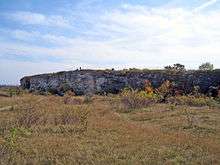Stránská skála
| Stránská skála | |
|---|---|
| Paleontological site | |
|
Toppath on Stránská skála | |
| Highest point | |
| Elevation | 255–310 m (837–1,017 ft) |
| Coordinates | 49°11′26.05″N 16°40′32.66″E / 49.1905694°N 16.6757389°ECoordinates: 49°11′26.05″N 16°40′32.66″E / 49.1905694°N 16.6757389°E |
| Dimensions | |
| Area | 136 acres (55 ha) |
| Geography | |
 Stránská skála Location in Brno, Moravia, Czech Republic, | |
| Location | Czech Republic—Moravia |
| Parent range | Brno Highlands |
| Geology | |
| Age of rock | Middle Pleistocene |
Stránská skála (often without diacritics as Stranska skala) is a hill and refers to a Mid-Pleistocene-Cromerian interglacial most important paleontological site in Central Europe. It is situated in the eastern part of Brno, Moravia near the city districts Židenice/Juliánov and Slatina, dating to approximately 600,000 BP, as supported by paleomagnetic dating. It is a 1500 m long and 400 m wide hill, built from Jurassic limestone, especially Callovian-Oxfordian, built from light brown Caleidocrinus (Crinoid) mostly and Brachiopoddes and Coral and more other types of limestones rich of fossil fauna as well. Stránská skála hill is located in Bohemian Massif (and right on the border between the two geological provinces): Bohemian Massif (Moravian Karst) and Carpates (Western Subcarpathia- Dyje-Svratka Vale). Its northwestern slope is composed from karstified limestone cliffs in which numerous fossiliferous fissures and caves were found. Approximately 48 meter of this slope are covered by complex talus fan.
At this place extensive excavations were made by paleonthologist Rudolf Musil and his colleagues in 1956-1968 which yielded rich paleothological material, including Homotherium moravicum[1] teeth and approximately 1600 bones and bone fragments of birds from 23 families, 51 genera and 68 species. Earlier (1943) were Ursus deningeri discovered, an later rich spectrum of coastal animal fossils such as ostracods, bivalves and fishes. The other terrestrial fossil animals are represented mostly of snakes. The site is unique in that it has been a particularly abundant source of prehistoric artifacts (especially stone tools) dating from the Acheulean period, ower Baradostian to Neolitics and Eneolitics, which spanned roughly 27,000 to 20,000 B.C. In addition to the abundance of various stone tools were discovered also fireplaces (the older one 250.000 BP).4
See also
References
- Valoch, Karel (1989). The Early Upper Palaeolithic in the Eastern Part of Central Europe, Anthropologie XXVII, 2–3, 89–91.
- Valoch, Karel (2000). More on the Question of Neanderthal Acculturation in Central Europe, in:Current Anthropology 41:4, 625–626. Chicago
- Mlíkovský, Jiří, (2002): Early Pleistocene birds of Stránská skála, Czech Republic: 2. Absolon's cave. Sylvia 38: s. 19–27
- ↑ M. Anton et al.: Co-existence of scimitar-toothed cats, lions and hominins in the European Pleistocene. Implications of the post-cranial anatomy of Homotherium latidens (Owen) for comparative palaeoecology. Quaternary Science Reviews 24 (2004).
Further reading
- Musil, Rudolf (ed.1995): Stránská skála Hill. Excavation of open-air sediments 1964-1972. Antropos, Brno 1995, ISBN 3-7749-2798-7 (Antropos, English).
- Musil, Rudolf (1968), Valoch Karel: Stránská skála: Its meaning for Pleistocene Studies.- Current Anthropology 9/5, part II, 534-539, Glasgow.
- Musil, Rudolf (1999): The environment in Moravia during the stage 3.- State of the Stage Project at the Start of its fourth Phase, News 7, 69-78, Cambridge.
- Musil, Rudolf (2003): The Early Upper Palaeolithic Fauna from Stránská skála. In: J.A. Svoboda and Ofer Bar –Yosef, Eds.: Stránská Skála. Origins of the Upper Palaeolithic in the Brno Basin, Moravia, Czech Republic.- American School of Prehistoric Research Bulletin 47, Dolní Věstonice Studies 10, 213-218, Peabody Museum of Archaeology and Ethnology, Harvard University
External links
- National Nature Monuments in CR: Stránská skála (English)
- Stránská skála Hill PDF 16 Seiten, English.
- City trafic connection - Tram time table line N°10 TO (on line, Czech)
- City trafic connection - Tram time table line N°10 OF (on line, Czech)
